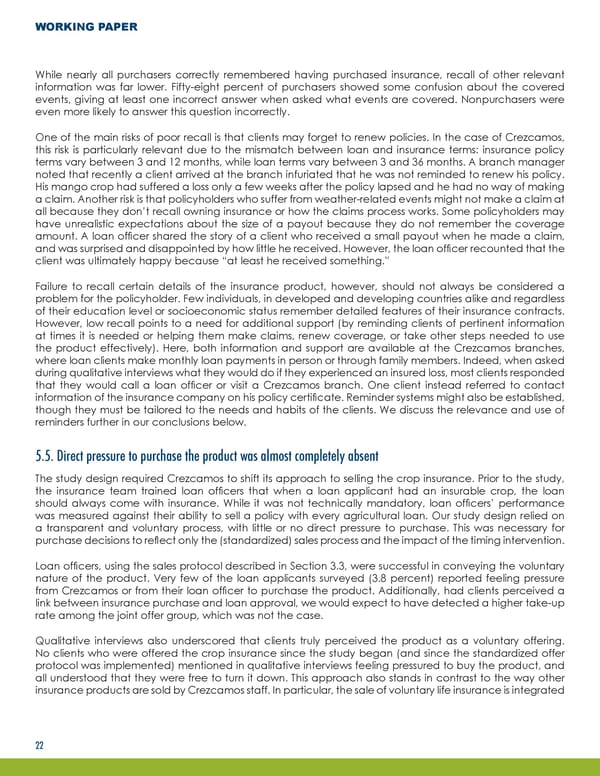WORKING PAPER While nearly all purchasers correctly remembered having purchased insurance, recall of other relevant information was far lower. Fifty-eight percent of purchasers showed some confusion about the covered events, giving at least one incorrect answer when asked what events are covered. Nonpurchasers were even more likely to answer this question incorrectly. One of the main risks of poor recall is that clients may forget to renew policies. In the case of Crezcamos, this risk is particularly relevant due to the mismatch between loan and insurance terms: insurance policy terms vary between 3 and 12 months, while loan terms vary between 3 and 36 months. A branch manager noted that recently a client arrived at the branch infuriated that he was not reminded to renew his policy. His mango crop had suffered a loss only a few weeks after the policy lapsed and he had no way of making a claim. Another risk is that policyholders who suffer from weather-related events might not make a claim at all because they don’t recall owning insurance or how the claims process works. Some policyholders may have unrealistic expectations about the size of a payout because they do not remember the coverage amount. A loan officer shared the story of a client who received a small payout when he made a claim, and was surprised and disappointed by how little he received. However, the loan officer recounted that the client was ultimately happy because “at least he received something.” Failure to recall certain details of the insurance product, however, should not always be considered a problem for the policyholder. Few individuals, in developed and developing countries alike and regardless of their education level or socioeconomic status remember detailed features of their insurance contracts. However, low recall points to a need for additional support (by reminding clients of pertinent information at times it is needed or helping them make claims, renew coverage, or take other steps needed to use the product effectively). Here, both information and support are available at the Crezcamos branches, where loan clients make monthly loan payments in person or through family members. Indeed, when asked during qualitative interviews what they would do if they experienced an insured loss, most clients responded that they would call a loan officer or visit a Crezcamos branch. One client instead referred to contact information of the insurance company on his policy certificate. Reminder systems might also be established, though they must be tailored to the needs and habits of the clients. We discuss the relevance and use of reminders further in our conclusions below. 5.5. Direct pressure to purchase the product was almost completely absent The study design required Crezcamos to shift its approach to selling the crop insurance. Prior to the study, the insurance team trained loan officers that when a loan applicant had an insurable crop, the loan should always come with insurance. While it was not technically mandatory, loan officers’ performance was measured against their ability to sell a policy with every agricultural loan. Our study design relied on a transparent and voluntary process, with little or no direct pressure to purchase. This was necessary for purchase decisions to reflect only the (standardized) sales process and the impact of the timing intervention. Loan officers, using the sales protocol described in Section 3.3, were successful in conveying the voluntary nature of the product. Very few of the loan applicants surveyed (3.8 percent) reported feeling pressure from Crezcamos or from their loan officer to purchase the product. Additionally, had clients perceived a link between insurance purchase and loan approval, we would expect to have detected a higher take-up rate among the joint offer group, which was not the case. Qualitative interviews also underscored that clients truly perceived the product as a voluntary offering. No clients who were offered the crop insurance since the study began (and since the standardized offer protocol was implemented) mentioned in qualitative interviews feeling pressured to buy the product, and all understood that they were free to turn it down. This approach also stands in contrast to the way other insurance products are sold by Crezcamos staff. In particular, the sale of voluntary life insurance is integrated 22
 Responsible Bundling of Microfinance Services Page 24 Page 26
Responsible Bundling of Microfinance Services Page 24 Page 26